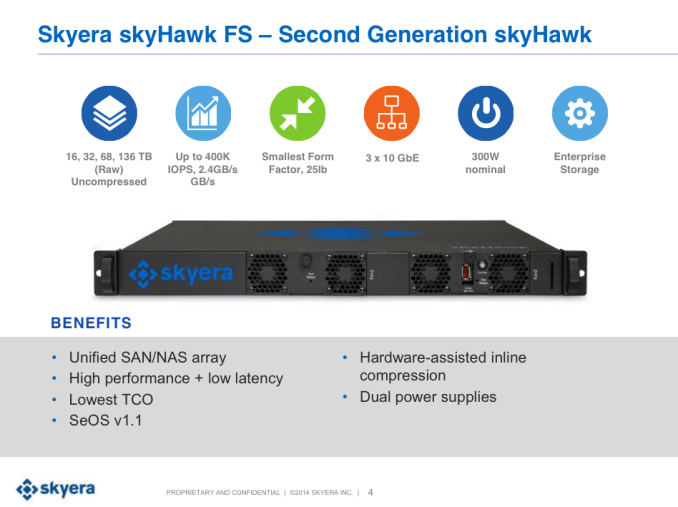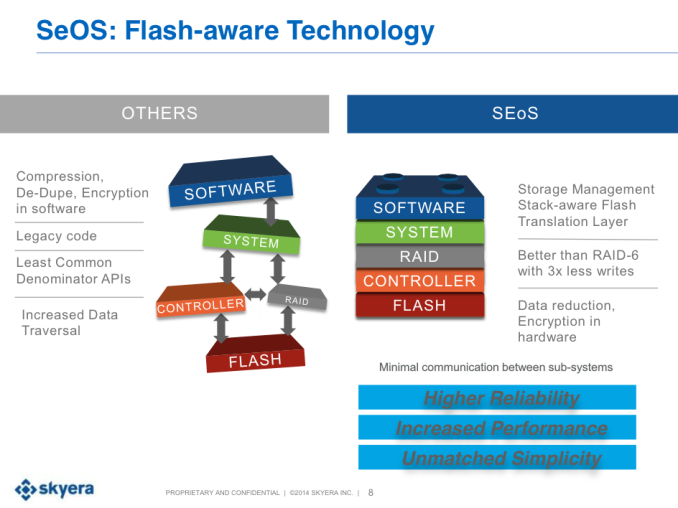Skyera Releases skyHawk FS All-Flash Array: Up to 136TB of NAND in 1U
by Kristian Vättö on October 29, 2014 4:00 PM EST
Our enterprise storage coverage has mainly been focused on individual enterprise SSDs from the likes of Intel and Micron, but there's a lot of interesting action in the storage array space. I met with most of the big names in the array business at Flash Memory Summit this year, so with a better understanding of the market and with the right contacts, I think it's logical that we expand our enterprise storage content to cover arrays as well.
Since we haven't covered storage arrays or the companies involved in the past, I'll start with a brief introduction of Skyera. While Skyera is a relatively new company, the company is filled with experience and knowledge of storage and non-volatile memory industries. The founders of Skyera, Radoslav Danilak and Rod Mullendore, both worked at SandForce before founding Skyera in 2010. Mr. Danilak was actually the co-founder and CTO of SandForce, whereas Mr. Mullendore served as the Chief Hardware Architect.
While Mr. Danilak and Mr. Mullendore bring a lot of system-level hardware design knowledge to the company, what really separates Skyera from the rest is the NAND expertise. This is especially thanks to the CEO, Frankie Roohparvar, who was one of the founders of Micron Quantum Technologies in the early 90s. Micron Quantum Technologies was a manufacturer of NOR flash that was then acquired by Micron and basically formed the foundation of Micron's NAND business. Before joining Skyera in 2012, Mr. Roohparvar served at Micron for 13 years with his most recent position being the Vice President and General Manager of the OEM Division of Micron's NAND Solutions Group.
Skyera's approach to flash array design is to start from the lowest level, i.e. the NAND silicon. Obviously the company doesn't manufacture its own NAND but Micron, Toshiba, and SK Hynix are all investors in the company, which ensures a steady supply of NAND and also gives Skyera much deeper access to NAND than what typical customers get. What this means is that Skyera can run its own validation and 'trimming' (optimizing the read/write parameters etc.) process on the NAND to boost the endurance. The benefit is lower cost because Skyera's own process can increase the endurance of normal MLC NAND from ~3,000 P/E cycles to over 30,000 P/E cycles (or so I was told), whereas most companies are limited to buying off-the-shelf NAND, which either means cheap but low endurance cMLC or expensive eMLC.
With the brief introduction of Skyera out of the way, let's focus on the skyHawk FS. It's offered in raw capacities of 16, 32, 68 and 136TB with all models utilizing the same 1U form factor. The final usable capacity depends on the provisioning of the array as well as the compressibility of the data since the skyHawk FS does compression in hardware (similar to what SandForce does). For comparison, Pure Storage, which is one of the leading all-flash array suppliers, only offers up to 11TB in 2U form factor, so Skyera has an enormous advantage in terms of density.
EDIT: Skyera doesn't actually do de-duplication like I initially said, so sorry for the mix up. The compression is still there, though.
The density advantage comes from Skyera's NAND expertise because the company builds its own drives (or blades as they are usually called) and can utilize the latest NAND lithographies available. While Skyera didn't specify the exact NAND that is used in the skyHawk FS due to the fact that there are multiple suppliers, I was told that the die capacity is 128Gbit and Micron's 16nm is one of the processes that is used. For the record, Crucial's MX100 and Micron's M600 are the only other products that I know of that use 16nm NAND right now and I know for sure that 16nm isn't available to the public in volume yet, so Skyera has an enormous advantage thanks to the close relations with the NAND manufacturers.
Software wise the skyHawk FS uses Skyera's own SEoS that has been designed solely for NAND. The vertically integrated business model allows Skyera to build the whole software stack around NAND, which enables a more global and adaptive Flash Translation Layer (FTL) for instance (i.e. the FTL can be managed at the system level instead of drive level). The design also allows the load to be split between the master controllers and the individual controllers in the blades for higher and more efficient performance, whereas with third party drives the drives would be doing their own management and the global/host management would be left for the master controller, resulting in a less efficient design.
In terms of performance, Skyera is rating the skyHawk FS at 2.4GB/s throughput and 400K IOPS with microsecond latencies, but unfortunately the IO sizes and queue depth are unspecified, so it's hard to draw any conclusions or comparisons from the numbers. The skyHawk FS has three 10Gbit Ethernet ports for connectivity and both iSCSI and NFS v3 protocols are supported. The skyHawk FS carries a 3-year warranty with no write endurance limitation, which is yet another advantage of Skyera's NAND knowhow.
The skyHawk FS is available immediately and is priced at $2.99 per raw gigabyte (i.e. with compression the real cost per gigabyte will come down).
Since this was our first flash array news post, I'd like to hear your feedback in the comments below. Would you like to see more content like this from us in the future? And if so, are there any specific topics or companies that you would like us to cover? The enterprise storage space is rather complex and there are a lot of companies involved, but we want to do our best to cover it (even in a limited matter) in the future, so let us know your thoughts.












34 Comments
View All Comments
mevans336 - Wednesday, October 29, 2014 - link
So their base model costs $50,000 for 16TB? All flash or not, I'm not impressed.Beany2013 - Wednesday, October 29, 2014 - link
If you're running a large dataset with high performance requirements, that $50,000 could pay for itself if you can do more business with it.Take Amazon - if they can get a 25% increase in usable, full load storage from these devices than they can with a device half the price, it'll still pay for itself pretty damned quickly. Especially if it uses less power, requiring less CRAC, more storage per rack, etc.
Once you get beyond a certain scale (in terms of customer base and performance requirements) this stuff really, really matters - $150,000 of storage is cheaper than having to blow millions on a new DC.
3DoubleD - Wednesday, October 29, 2014 - link
My thoughts exactly. A cool $406,640 for the 136TB version! That's one crazy expensive 1U server!When you are buying this many TBs, you'd think you should at least be getting < $1/GB. On the consumer end, I can't wait until they can get something like this down to the $0.1/GB range. Not sure if that'll even happen in 10 years though... I can dream.
DanNeely - Wednesday, October 29, 2014 - link
Big enterprise storage is far more expensive than consumer storage. You're primarily paying for all the custom software/hardware needed to build SAN systems; and the small number of customers buying that sort of hardware (relative to the consumer or SMB markets) means each one ends up paying for a significant fraction of the total custom engineering/integration labor needed to make it work.Ushio01 - Wednesday, October 29, 2014 - link
HEH, in the rackmount SSD space Skyera are a budget brand. If you want expensive go look at Kove and Kaminario rackmount SSD's.PCTC2 - Wednesday, October 29, 2014 - link
I know of distributed file systems that are disk-based that are more than $1/GB for I can say, from an HPC/Big Data/Enterprise standpoint, these are worth the money if they provide some lowered TCO/increased performance based on density and reliability. Cost of hardware is NOTHING compared to total TCO that large enterprise faces when it comes to Infrastructure.Guspaz - Wednesday, October 29, 2014 - link
Why aren't you impressed? That's very cheap for Enterprise flash storage. Fusion-IO charges 60% more than that for just the raw flash PCIe cards themselves (let alone the appliance they go in), and Intel charges about 30% more for the raw cards (again, before you even get into the appliance cost).UltraTech79 - Saturday, November 1, 2014 - link
Why isnt he? Because he is like a monkey looking at a CPU tossed in his cage. He doesn't know what he's looking at.repoman27 - Thursday, October 30, 2014 - link
What impresses me is the sheer amount of silicon in the 136 TB box. Using Micron's 16 nm, 128 Gbit NAND, that's 8,500 dies in a 1U enclosure. With a die size of ~173 mm^2, that's almost 1.5 m^2 of silicon, or more than 24 wafers worth! It should be called sandBox instead of skyHawk, but I guess that name wouldn't be sufficiently "cloudy".nekoken - Wednesday, October 29, 2014 - link
It would be interesting to see more information about redundancy and backups. Do they have tooling like Netapp for mirroring volumes within the chassis or to a volume on another chassis? How about redundancy within the volume? What's the primary market they are going for? Enterprise class storage with carrier grade safety built in or high performance, fault tolerant storage?